It's a sad if not tragic irony that a“Festival of Advanced Music and Multimedia Art” should (also) be the site of mass cultural and social regression, but the longer you spend at Sonar the harder its negative aspects become to ignore.
Sonar is a legend and has surely played host to some incredible performances (this year included) but it is also a symptom of wider cultural and social malaise. I'd never been to the festival but I'd heard from (some) who'd been there in previous years both that it was good and that it wasn't as good as it was.
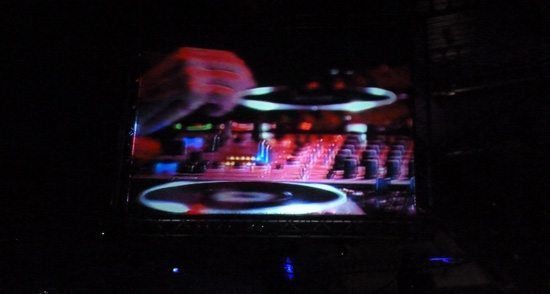 So, although I wasn't expecting it to be as incredible as some people said it had once been, neither was I expecting what I found. To put it bluntly, it immediately became apparent that Sonar has become a fixture on the college/hen/stag party circuit and is attracting some of the kind of people that give small English towns such a bad name.
So, although I wasn't expecting it to be as incredible as some people said it had once been, neither was I expecting what I found. To put it bluntly, it immediately became apparent that Sonar has become a fixture on the college/hen/stag party circuit and is attracting some of the kind of people that give small English towns such a bad name.
Joining them for the revelry were American college students and legions of young, hyped-up Spaniards. Barcelona has an increasingly seedy feel to it and I have the impression that the British drink-all-you-can crowd are involved in a kind of arms race with the some of the locals to out-regress each other. The majority of the crowd on the festival transit buses were quite different to those you'd usually encounter at serious music festivals. For many of them Sonar seemed only to be a stage or a pretext for epic binging and judging by the level of musical knowledge/indifference displayed they might as well have been dancing to chart pop in a provincial vertical drinking establishment but that wouldn't be such a laugh would it? The young English girl slumped on a table in the well-stocked food area will at least be able to boast of having once passed out at Sonar rather than O'Neills.
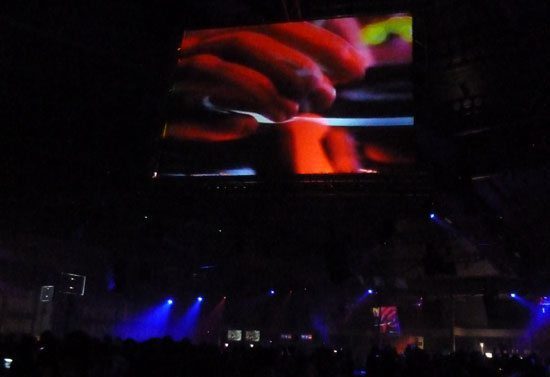 Sonar's perverse (or self-consciously “arty”) programming seems to be based on the sonically correct dogma that everyone is (or should be) equally interested in all styles. Sonar By Night is grouped into different (and slightly risibly) named areas including Sonar Lab, Sonar Club and most tellingly: Sonar Car. The result is that anyone either whose tastes are too specialised or whose senses haven't been reduced to the level where everything seems the same suffers long periods wandering from area to area in decreasing hope of inspiration while waiting for the acts they're really interested in.
Sonar's perverse (or self-consciously “arty”) programming seems to be based on the sonically correct dogma that everyone is (or should be) equally interested in all styles. Sonar By Night is grouped into different (and slightly risibly) named areas including Sonar Lab, Sonar Club and most tellingly: Sonar Car. The result is that anyone either whose tastes are too specialised or whose senses haven't been reduced to the level where everything seems the same suffers long periods wandering from area to area in decreasing hope of inspiration while waiting for the acts they're really interested in.
Sonar Club is the area where the biggest names played and so inevitably there was a wide spread of styles and artists. It seems rather unlikely that many people wanted to see Human League, M.I.A. and then Aphex Twin DJ'ing. This meant that there was a regular changeover of crowds at the end of sets, giving an unwelcome chance to get up close and personal with the large number of people who simply walk through or into others who happen to be coming in the opposite directions. I've been to many squat parties, commuted regularly on the tube but only here at this corporate dance event have I encountered such aggressive indifference to others. This created a disillusioning atmosphere comprised of boredom, alienation and disbelief.
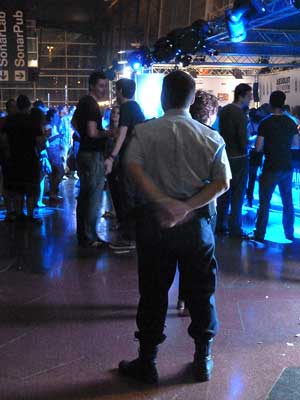 The Sonar Car area (can you guess what it is yet?) was the best place to rest but also the best place to stare into the void of cultural alienation. Benches and tables are laid out at the back of a cavernous exhibition hall. Looking around the tables it was clear that there were others desperately looking around and hoping for something interesting to happen to fill the long gaps between worthwhile sets. On the first night in particular the serious music audience were a small and visibly disappointed minority, lost in a sea of vapid party goers entranced by each other, the fact they were in Barcelona and (in many cases) the bumper cars that give the neon-lit Sonar Car area its name. At the end of each bumper car round a changeover signal would sound and for most of the time this was much more interesting than the DJ's and live acts playing on a fairground stage in the area behind the cars. The one welcome exception to this was the (male) Italian DJ Lucy who played minimal house/techno with subtle percussive elements. Perhaps surrounded by less bland and actively bad material it might not have stood out so much but as it was it was a huge relief, at last restoring some vitality to the last night.
The Sonar Car area (can you guess what it is yet?) was the best place to rest but also the best place to stare into the void of cultural alienation. Benches and tables are laid out at the back of a cavernous exhibition hall. Looking around the tables it was clear that there were others desperately looking around and hoping for something interesting to happen to fill the long gaps between worthwhile sets. On the first night in particular the serious music audience were a small and visibly disappointed minority, lost in a sea of vapid party goers entranced by each other, the fact they were in Barcelona and (in many cases) the bumper cars that give the neon-lit Sonar Car area its name. At the end of each bumper car round a changeover signal would sound and for most of the time this was much more interesting than the DJ's and live acts playing on a fairground stage in the area behind the cars. The one welcome exception to this was the (male) Italian DJ Lucy who played minimal house/techno with subtle percussive elements. Perhaps surrounded by less bland and actively bad material it might not have stood out so much but as it was it was a huge relief, at last restoring some vitality to the last night.
The previous night however only reached any kind of vitality with the set by Aphex Twin, of which more later. The evening began what seemed like several centuries earlier with a set by the Human League. Fortunately they didn't just play their cheesier hits but some older material including the classic Being Boiled. It sounded strong and persuasive but the visuals were more surprising (at least for someone who hasn't previously seen the group live).
 The Sonar Club area is truly vast and there are screens on either side of the stage but also along the two side walls, creating an impressive stadium spectacle. It's hard then to say whether showing footage of Hitler speaking at a Nazi rally was more inappropriate or highly symbolic of Sonar-style corporate entertainment on an industrial scale. It seemed both a little clumsy and extremely apt.
The Sonar Club area is truly vast and there are screens on either side of the stage but also along the two side walls, creating an impressive stadium spectacle. It's hard then to say whether showing footage of Hitler speaking at a Nazi rally was more inappropriate or highly symbolic of Sonar-style corporate entertainment on an industrial scale. It seemed both a little clumsy and extremely apt.
Following this strangely symbolic slice of eighties nostalgia the search for something to bridge the yawning chasm separating this and the set by Aphex Twin began. In the Sonar Pub area, a long space with large stage open to the air I observed the Sunday supplement-celebrated Trentemøller playing the sonic equivalent of an IKEA catalogue minus the page-turning thrills. Achingly tasteful, indie-inflected dance populism systematically purged of any character or point beyond narcissistic self-celebration.
The biggest draw in the Sonar Club area that night seemed to be M.I.A. Here's an artist with an interesting cultural-political backstory and widespread critical acclaim so curiosity demanded she be given a chance (despite the fact that she seemed to be the biggest draw for the a- or anti-musical party crowd. Not having seen her before it's hard to say whether she was playing down to the crowd but it was hard to discern much beyond functional call-and-response populism with a very vague political edge. It wasn't simply that it was bad just that compared to the hype surrounding what Sonar's programe called “a key figure in musical art”(!) it was that it was so deeply ordinary with a nasty streak of dumbness to get the crowd hyped up.
This was followed by what on paper looked like a promising set by (post?)-dubstep producer Scuba. Having heard some interesting tracks by him and was interested to see what this Berghain resident could do. Hope soon faded however. Rather than state-of-the-art dubstep or electronica what I heard was blandly housey and rapidly energy-sapping. Waiting for this to finish we strolled around in weary disbelief.
All this meant that a great deal hinged on Richard D. James coming up with something sufficiently spectacular to justify the preceding hours of tedium. Here at last was an artist who lived up to his own legend (this was all the more impressive given how much I needed his set to be good and that, I was finally seeing him after following him for almost two decades).
 This wasn't the most spectacular Aphex set (no dancing teddy bears or sandpaper on turntables) but was very assured and impressive, visually as well as sonically. The de rigeur Aphex tropes were all present and correct: jokey slogans, figures with grotesquely Aphexed faces (including the Spanish football team) and a mix of his own material plus some classic acid tracks with a few cheeky samples dropped in here and there.
This wasn't the most spectacular Aphex set (no dancing teddy bears or sandpaper on turntables) but was very assured and impressive, visually as well as sonically. The de rigeur Aphex tropes were all present and correct: jokey slogans, figures with grotesquely Aphexed faces (including the Spanish football team) and a mix of his own material plus some classic acid tracks with a few cheeky samples dropped in here and there.
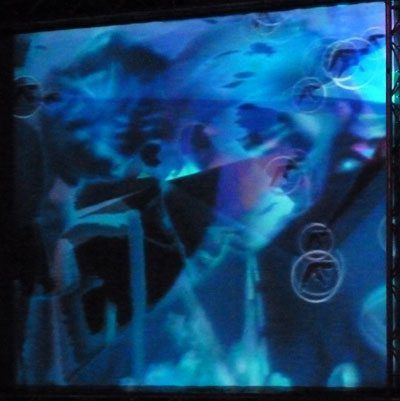 I had been apprehensive Richard James might be play a too-clumsily humorous set but it was almost always serious and when those classic Aphexian chords kicked in, occasionally even beautiful. If my mood hadn't been so comprehensively soured by the crowd and the general mediocrity preceding his set it probably would have been even more enjoyable. So while this wasn't a revelation it was certainly far from a disappointment and it is worth seeing Aphex if you get the chance to do so.
I had been apprehensive Richard James might be play a too-clumsily humorous set but it was almost always serious and when those classic Aphexian chords kicked in, occasionally even beautiful. If my mood hadn't been so comprehensively soured by the crowd and the general mediocrity preceding his set it probably would have been even more enjoyable. So while this wasn't a revelation it was certainly far from a disappointment and it is worth seeing Aphex if you get the chance to do so.
The second evening starts entirely differently in the fantastic location of the Cosmo Caixa, a futuristic science museum high above the sea. This is a grand and impressive location but its geographical remoteness also seemed to represent a kind of ghettoisation of the more “difficult”and advanced music in the programme. By locating it here there was no danger that the O'Neills crowd would accidentally be exposed to anything too cerebrally taxing. The Sound Aviaries: music and birds programme of performances, talks and installations could not have been more different in tone to the rest of Sonar.
Respected artists such as Jan Jelinek, BJ Nilsen, Carl Michael Von Hausswolff and others were involved. The highlight was a talk and performance by renowned Spanish sound artist Francisco Lopez. Speaking in two languages Lopez discussed and played examples of his bird song recordings from the Amazon. After a short break he then fashioned these into a massive, unstable soundscape. This was the first truly thrilling performance of the event, sounding like brutalised bird song recordings played on a massive feedback-ridden sound system at a squat party. It was only a shame that it wasn't louder and that some of the more attention-deficit- disorder-affected members of the seated audience weren't able to suspend their banal chatter for the full performance.
Newly energised by Lopez it was time to rush down to Sonar By Night in time to catch Chris Cunningham's renowned audiovisual performance. This was one case where Sonar's juxtaposition of crowds and artists actually worked as it attracted both a more “serious” audience familiar with the work plus a steady stream of curious onlookers drawn by the spectacular and intriguing visuals.
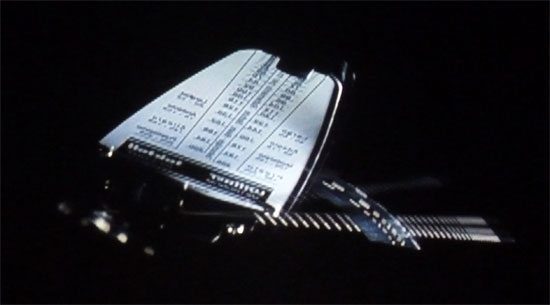
Although the formula of dark electronica and arty visuals was no surprise, the skill with which it was executed was still impressive. Beats were exactly synchronised with the hyperactive but detailed imagery, which drew spontaneous applause from the crowd several times. Cunningham played a mix of his own (unreleased) tracks and tracks by other producers. Most of the films tell bizarre stories of mutation or violence and are full of disturbing symbolism. The long and brutal sequence of a naked couple fighting in Flex was both disturbing and fascinating in a live rather than gallery context.

The only point that was less convincing was New York Is Killing Me, a music video for Gil Scott-Heron. Long sequences of New York skyscrapers and the subway are easy “cool triggers” that an artist can rely on to function well for most audiences but compared to the hyper-kinetic and symbolically rich videos preceding it seemed fairly pedestrian. Overall, it was hard to say what exactly the point of the performance was beyond a demonstration of technical prowess and disturbing atmospheres, although thinking about the possible meanings behind the darker films and how you relate to them does open up some interesting questions (although, how many of the audience actually do this is an open question).
After this thought-provoking spectacle it was “blandness as usual” at Sonar. Starting the by-now traditional room-to-room trek led us into Africa Hitech's set where we caught a snatch of aggressively unremarkable and surprisingly old-fashioned M.C.-led drum and bass. There was then a chance to finally see the much-hyped Shackleton. The beats and textures seemed well-crafted yet couldn't compete with and even added to the pervasive air of ennui and generalised mediocrity.
There was nothing “wrong” with it but it failed to energise or inspire, perhaps because it was so tasteful. “Dubstep-supergroup” Magnetic Man were clumsily (and inaccurately) billed by Sonar as “dubstep power for all tastes.” From the start it was clear that this was actually the dubstep equivalent of macho cock rock but with keyboards and basslines. A populist M.C. plus emphatically dumb tracks created an alienation effect that revealed much about the (inevitable) assimilation of dubstep and how eagerly it collaborates with stultifying mainstream culture.
As the website itself stated, “taking the helm at SonarClub after the show by Magnetic Man requires the special touch of an expert” and it was to Birmingham techno legend Surgeon that the duty fell of reviving the terminally ill patient that was Sonar. What was immediately apparent was the change in the crowd: suddenly this felt like the kind of serious (and far less obnoxious) music crowd you would expect were Sonar really what it claims to be. The crowd may have been two-thirds smaller but they were enthusiastic from the first beats. A Surgeon set is always a precision display and was a desperately-needed contrast to what had gone before. It was serious but not austere and (subtly) populist enough to combine danceability with quality. The only weak point was his now obligatory mid-set excursion into dubstep. I can see that there could be an interesting techno/dubstep crossover but although the tracks chosen were impressive in themselves I wasn't fully convinced. The set suddenly became much simpler and more static than what went before and after and temporarily lost momentum.
And so it was that at a metaphorical two minutes to midnight and an actual 05.45, the mysterious American techno producer Silent Servant took to the stage and at the last possible moment for the festival delivered something largely breathtaking. Although the austere black and white visuals, harsh hisses and cold beats soon thinned the crowd further, the last survivors were (finally) privileged to witness something unforgettable.
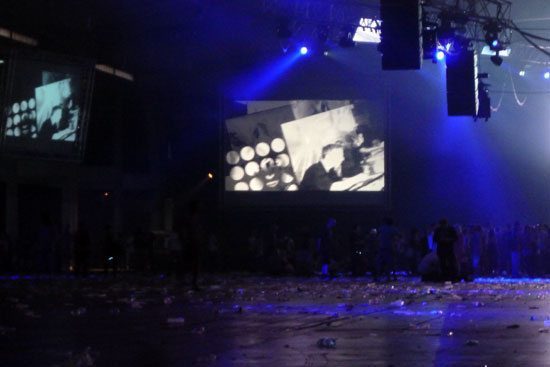 The first forty minutes were exactly what you would expect from a member of the Sandwell District collective: cold, hard techno that created an exhilarating effect. For a time it was possible to forget the ennui and exhaustion induced by previous acts and fully enjoy the colossal but sadly empty space.
The first forty minutes were exactly what you would expect from a member of the Sandwell District collective: cold, hard techno that created an exhilarating effect. For a time it was possible to forget the ennui and exhaustion induced by previous acts and fully enjoy the colossal but sadly empty space.
 Although there was a housier interlude during which the set lost some of its force it recovered well and remained impressive, even as the cleaning teams prepared to start work and daylight began to creep into the space. As the crowd left the venue a wave of spontaneous applause began. At first it seemed to be self-congratulation or general exhilaration but on exiting it became clear that it was actually a salute to a stunning sunrise. Waiting for the Sonar bus back to the centre was a very ambivalent experience. There was exhilaration that Sonar had finally delivered, a renewed wave of alienation generated by some of the crowd, the feeling that the evenings should have started rather than finished with something as intense as Silent Servant… and a regretful but clear determination never to do Sonar again.
Although there was a housier interlude during which the set lost some of its force it recovered well and remained impressive, even as the cleaning teams prepared to start work and daylight began to creep into the space. As the crowd left the venue a wave of spontaneous applause began. At first it seemed to be self-congratulation or general exhilaration but on exiting it became clear that it was actually a salute to a stunning sunrise. Waiting for the Sonar bus back to the centre was a very ambivalent experience. There was exhilaration that Sonar had finally delivered, a renewed wave of alienation generated by some of the crowd, the feeling that the evenings should have started rather than finished with something as intense as Silent Servant… and a regretful but clear determination never to do Sonar again.
In part the lacklustre selection may also be a reflection of hard times. After all, another very different 2011 music festival the BBC Proms is also playing it safe with easy populism and leaving only a bare minimum of truly innovative or challenging content. Yet the (ultimately self-defeating) “economic necessity” argument lets Sonar off the hook too easily. There's a tiring and unjustified smugness and complacency surrounding the event. This is visible in the “Techno Essence” part of the programme: a cobbled-together list of vaguely related artists, at least half of whom are related to techno only in the way that they confound or ignore what Sonar calls “the essence of techno (darkness, depth, the glimpse of an imminent future).”
It seems that Sonar is both the victim of its own success and the author of its own misfortune. Having become such a huge phenomenon it has both to sustain itself and to keep expanding. It attempts to do this while still presenting itself as a serious festival, parasitically relying on its own history and the bare minimum of serious artists to lend it artistic credibility. If Sonar represents the future of electronic music and culture then long live the past.
Sónar and CosmoCaixa. Sound Aviaries: music and birds.

The aim of art is to represent not the outward appearance of things, but their inward significance. – Aristotle
















